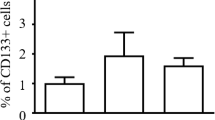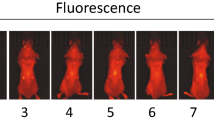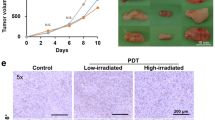Abstract
Photodynamic therapy (PDT) is a promising treatment modality for head and neck, and other tumours, using drugs activated by light. A second generation drug, 5-aminolaevulinic acid (5-ALA), is a precursor of the active photosensitizer protoporphyrin IX (PpIX) and has fewer side-effects and much more transient phototoxicity than previous photosensitizers. We have investigated the effect of 5-ALA mediated PDT in combination with γ-irradiation on the colony forming ability of several human head and neck tumour cell lines. The effect of treatments on the DNA cell cycle kinetics was also investigated. Our results indicate that the combination of 5-ALA mediated PDT and γ-irradiation results in a level of cytotoxicity which is additive and not synergistic. 5-ALA mediated PDT had no discernible effect on DNA cell cycle distributions. γ-irradiation-induced cell cycle arrest in G2 did not enhance the phototoxicity of 5-ALA. © 2000 Cancer Research Campaign
Similar content being viewed by others

Article PDF
Change history
16 November 2011
This paper was modified 12 months after initial publication to switch to Creative Commons licence terms, as noted at publication
References
Baas P, Michielsen C, Oppelaar H, van Zandwijk, & Stewart FA (1994) Enhancement of interstitial photodynamic therapy by mitomycin C and E09 in a mouse tumour model. International Journal of Cancer 56: 880–885
Baas P, van Geel IPJ, Oppelaar H, Meyer M, Beynen JH, van Zandwijk N & Stewart FA (1996) Enhancement of photodynamic therapy by mitomycin C: a preclinical and clinical study. British Journal of Cancer 73: 945–951
Battle AMC (1993) Porphyrins, porphyrias, cancer and photodynamic therapy – a model for carcinogenesis. Journal of Photochemistry and Photobiology B Biology 20: 5–22
Bellnier DA & Dougherty TJ (1986) Haematoporphyrin derivative photosensitization and gamma-radiation damage interaction in chinese hamster ovary fibroblasts. International Journal of Radiation Biology 50: 659–664
Ben-Hur E, Kol R, Marko R, Riklis E & Rosenthal I (1988) Combined action of phthalocyanine photosensitization and gamma-radiation on mammalian cells. International Journal of Radiation Biology 54: 21–30
Berg K, Luksiene Z, Moan J & Ma LW (1995) Combined treatment of ionizing radiation and photosensitization by 5-aminolevulinic acid-induced protoporphyrin IX. Radiation Research 142: 340–346
Biel MA (1995) Photodynamic therapy of head and neck cancers. Seminars in Surgical Oncology 11: 355–359
Biel MA (1998) Photodynamic therapy and the treatment of head and neck neoplasia. Laryngoscope 108: 1259–1268
Boegheim JPJ, Dubbelman TMAR, Mullenders LHF & van Steveninck J (1987) Photodynamic effects of haematoporphyrin derivative on DNA-repair in murine L929 fibroblasts. Biochemical Journal 244: 711–715
Brock WA, Baker FL, Wike JL, Sivon SL & Peters LJ (1990) Cellular radiosensitivity of primary head and neck squamous cell carcinomas and local control. International Journal Of Radiation Oncology Biology-Physics 18: 1283–1286
Brown NC, Eliasson R, Reichard P & Thelander L (1969) Spectrum and iron content of protein B2 from ribonucleoside diphosphate reductase. European Journal of Biochemistry 9: 512–518
Bugelski PJ, Porter CW & Dougherty TJ (1981) Autoradiographic distribution of hematoporphyrin derivative in normal and tumout tissue of the mouse. Cancer Research 41: 4604–4612
Champion AR, Hanson JA, Court JB & Venables SE (1995) The micronucleus assay: an evaluation of its use in determining radiosensitivityin vitro. Mutagenesis 10: 203–208
Champion AR, Hanson JA, Venables SE, McGregor AD & Gaffney CC (1997) Determination of radiosensitivity in established and primary squamous cell carcinoma cultures using the micronucleus assay. European Journal of Cancer 33(3): 453–462
Chaudhuri K, Keck RW & Selman S (1987) Morphological changes of tumour microvasculature following hematoporphyrin derivative sensitised photodynamic therapy. Photochemistry and Photobiology 46: 823–827
Datta SN, Allmann R, Loh C, Mason M & Matthews PN (1997) Effect of photodynamic therapy in combination with mitomycin C on a mitomycin-resistant bladder cancer cell line. Br J Cancer 76: 312–317
Dougherty TJ (1988) Photodynamic therapyIn Medical Radiology – Innovations in Radiation Oncology, Withers HR, Peters LJ (eds) pp 175–188, Springer: Berlin
Dougherty TJ, Cooper MT & Mang TS (1990) Cutaneous phototoxic occurrences in patients receiving Photofrin. Lasers in Surgery and Medicine 10: 485–488
Feyh J (1996) Photodynamic treatment for cancers of the head and neck. Journal of Photochemistry and Photobiology B: Biology 36: 175–177
Girinsky T, Bernheim A, Lubin R, Tavakol-Razavi T, Baker F, Janot F, Wibault P, Cosset JM, Dwillard P, Duverger A & Fertil B (1994) In vitro parameters and treatment outcome in head and neck cancers treated with surgery and/or radiation: cell characterisation and correlations with local control and overall survival. International Journal of Radiation Oncology Biology-Physics 30: 789–794
Kastan MB, Zhan Q, el-Deiry WS, Carrier F, Jacks T, Walsh WV, Plunkett BS, Vogelstein B & Fornace AJ (1992) A mammalian cell cycle checkpoint pathway utilizing p53 and GADD45 is defective in ataxia-telangiectasia. Cell 71: 587–597
Kavarnos G, Nath R & Bongiorni P (1994) Visible-light and X irradiation of chinese hamster lung cells treated with hematoporphyrin derivative. Radiation Research 137: 196–201
Kennedy JC & Pottier RH (1994) Using δ-aminolevulinic acid in cancer therapyIn: Porphyric Pesticides: Chemistry, Toxicology and Pharmaceutical Applications, Duke SO, Rebeiz CA (Eds). ACS Symposium Series No 559 pp 291–301, American Chemical Society: Washington
Kennedy JC, Pottier RH & Pross DC (1991) Medical applications of selective tissue photosensitization induced by exogenous 5-aminolevulinic acid. Photochemistry and Photobiology 53: 100S
Kostron H, Swartz MR, Miller DC & Martuza RL (1986) The interaction of hematoporphyrin derivative, light and ionizing radiation in a rat glioma model. Cancer 57: 964–970
Kuerbitz SJ, Plunkett BS, Walsh WV & Kastam MB (1992) Wild-type p53 is a cell cycle checkpoint determinant following irradiation. Proc Natl Acad Sci USA 89: 7491–7495
Loh CS, Vernon D, MacRobert AJ, Bedwell T, Bown SG & Brown SB (1993) Endogenous porphyrin distribution induced by 5-aminolevulinic acid in the tissue layers of the gastrointestinal tract. Journal of Photochemistry and Photobiology B: Biology 20: 47–54
Ma LW, Moan J, Steen HB, Berg K & Peng Q (1992a) Effect of mitomycin C on the uptake of photofrin II in a human adenocarcinoma cell line. Cancer Letters 64: 155–162
Ma LW, Steen HB, Moan J, Berg K, Peng Q & Saether H Rimington C (1992b) Cytotoxicity and cytokinetic effects of mitomycin C and/or photochemotherapy in a human colon adenocarcinoma cell line. International Journal of Biochemistry 24: 1807–1813
Ma LW, Moan J, Berg K, Peng Q & Steen HB (1993a) Potentiation of photodynamic therapy by mitomycin C in cultured human colon adenocarcinoma cells. Radiation Research 134: 22–28
Ma LW, Iani V & Moan J (1993b) Combination therapy: photochemotherapy; electric current; and ionizing radiation. Different combinations studied in a WiDr human colon adenocarcinoma cell line. Journal of Photochemistry and Photobiology 21: 149–154
Nash JC (1979) Compact numerical methods for computers; linear algebra and function minimisation. Adam Hilger: Bristol
Nelson JS, Liaw LH & Berns MW (1987) Tumour destruction in photodynamic therapy. Photochemistry and Photobiology 46: 829–835
Ormerod MG, Payne AWR & Watson JV (1987) Improved program for the analysis of DNA histograms. Cytometry 8: 637–641
Peng Q, Warloe T, Berg K, Moan J, Kongshaug M, Giercksky KE & Nesland JM (1997) 5-Aminolevulinic acid based photodynamic therapy; clinical research and future challenges. Cancer 79(12): 2282–2308
Pourzand C, Reelfs O, Kvam E & Tyrell RM (1999) The iron regulatory protein can determine the effectiveness of 5-aminolevulinic acid in inducing protoporphyrin IX in human primary skin fibroblasts. Journal of Investigative Dermatology 112(4): 419–425
Prinsze C, Penning LC, Dubbelman TMAR & van Steveninck J (1992) Interaction of photodynamic treatment and either hyperthermia or ionizing radiation and of ionizing radiation and hyperthermia with respect to cell killing of L929 fibroblasts, chinese hamster ovary cells, and T24 human bladder cells. Cancer Research 52: 117–120
Reichard P & Ehrenberg A (1983) Ribonucleotide reductase – a radical enzyme. Science 221: 514–518
Rittenhouse-Diakun K, van Leengoed H, Morgan J, Hryhorenko E, Paszkiewicz G, Whitaker JE & Oseroff AR (1995) The role of transferrin receptor (CD71) in photodynamic therapy of activated and malignant lymphocytes using the haem precursor δ-aminolaevulinic acid. Photochemistry and Photobiology 61: 523–528
Schick E, Kaufman R, Ruck A, Hainzl A & Boehncke WH (1995) Influence of activation and differentiation of cells on the effectiveness of photodynamic therapy. Acta Dermato Venereologica 75: 276–279
Schnitzhofer GM & Krammer B (1996) Photodynamic treatment and radiotherpay combined effect on the colony-forming ability of V79 Chinese hamster fibroblasts. Cancer Lett 108: 93–99
Schuller DE, McCaughan JS & Rock RP (1984) Photodynamic therapy in head and neck cancer. Archives of Otolaryngology 111: 351–355
Selman SH, Kreimar-Birnbaum M, Klaunig JE, Goldblatt PJ, Keck RW & Britton SL (1984) Blood flow in transplantable bladder tumours treated with haematoporphyrin derivative and light. Cancer Research 44: 1924–1927
Star WM, Marjnissen HPA, van den Berg-Blok AE, Versteeg JA, Franken KA & Reinhold HS (1986) Destruction of rat mammary tumour and normal microcirculation by hematoporphyrin derivative photoradiation observed in vivo in sandwich observation chambers. Cancer Research 46: 2532–2540
van Dongen GA & Snow GB (1997) Prospects for future studies in head and neck cancer. European Journal of Surgical Oncology 23(6): 486–491
Watson JV, Chambers SH & Smith PJ (1987) A pragmatic approach to the analysis of DNA histograms with a definable G1 peak. Cytometry 8: 1–8
Weichselbaum RR, Dahleberg W, Little JB, Ervin TJ, Miller D & Hellman S (1984) Cellular x-ray repair parameters of early passage squamous cell carcinoma lines derived from patients with known responses to radiotherapy. British Journal of Cancer 49: 595–601
Weichselbaum RR, Beckett MA, Schwartz JL & Dritschilo A (1988) Radioresistant tumour cells are present in head and neck carcinomas that recur after radiotherapy. International Journal of Radiation Oncology Biology Physics 15: 575–579
Wile AG, Novotny J & Mason GR (1984) Photoradiation therapy of head and neck cancer. In Porphyrin Localisation and Treatment of Tumours. Doiron DR, Gomer CJ (eds), pp 681–693, AR Liss: New York
Wyld L, Smith O, Lawry J, Reed MWR & Brown NJ (1998) Cell cycle phase influences tumour cell sensitivity to aminolaevulinic acid-induced photodynamic therapy in vitro. British Journal of Cancer 78: 50–55
Author information
Authors and Affiliations
Rights and permissions
From twelve months after its original publication, this work is licensed under the Creative Commons Attribution-NonCommercial-Share Alike 3.0 Unported License. To view a copy of this license, visit http://creativecommons.org/licenses/by-nc-sa/3.0/
About this article
Cite this article
Allman, R., Cowburn, P. & Mason, M. Effect of photodynamic therapy in combination with ionizing radiation on human squamous cell carcinoma cell lines of the head and neck. Br J Cancer 83, 655–661 (2000). https://doi.org/10.1054/bjoc.2000.1328
Received:
Revised:
Accepted:
Published:
Issue date:
DOI: https://doi.org/10.1054/bjoc.2000.1328
Keywords
This article is cited by
-
Assessing of integration of ionizing radiation with Radachlorin-PDT on MCF-7 breast cancer cell treatment
Lasers in Medical Science (2016)
-
Enhanced effects of aminolaevulinic acid-based photodynamic therapy through local hyperthermia in rat tumours
British Journal of Cancer (2003)


